What body type are you. Body Type Diet: Ectomorph, Mesomorph, Endomorph – Optimize Your Nutrition and Fitness
What is your body type. How can you tailor your diet and exercise routine to your somatotype. Are there benefits to eating for your body type. What are the characteristics of ectomorphs, mesomorphs, and endomorphs.
Understanding Somatotypes: The Three Main Body Types
The concept of body types, or somatotypes, was first introduced by psychologist William Herbert Sheldon in the 1940s. While his initial attempt to link personality traits to physical characteristics has been largely discredited, the classification of body types remains relevant in the fields of nutrition and fitness. The three main somatotypes are ectomorph, mesomorph, and endomorph.
What are the defining characteristics of each body type? Let’s explore:
- Ectomorph: Lean and lanky with a fast metabolism
- Mesomorph: Athletic and muscular with a moderate metabolism
- Endomorph: Curvy or stocky with a slower metabolism
It’s important to note that most people are not purely one type but rather a combination of two or more. Understanding your dominant body type can help guide your nutrition and exercise choices for optimal results.
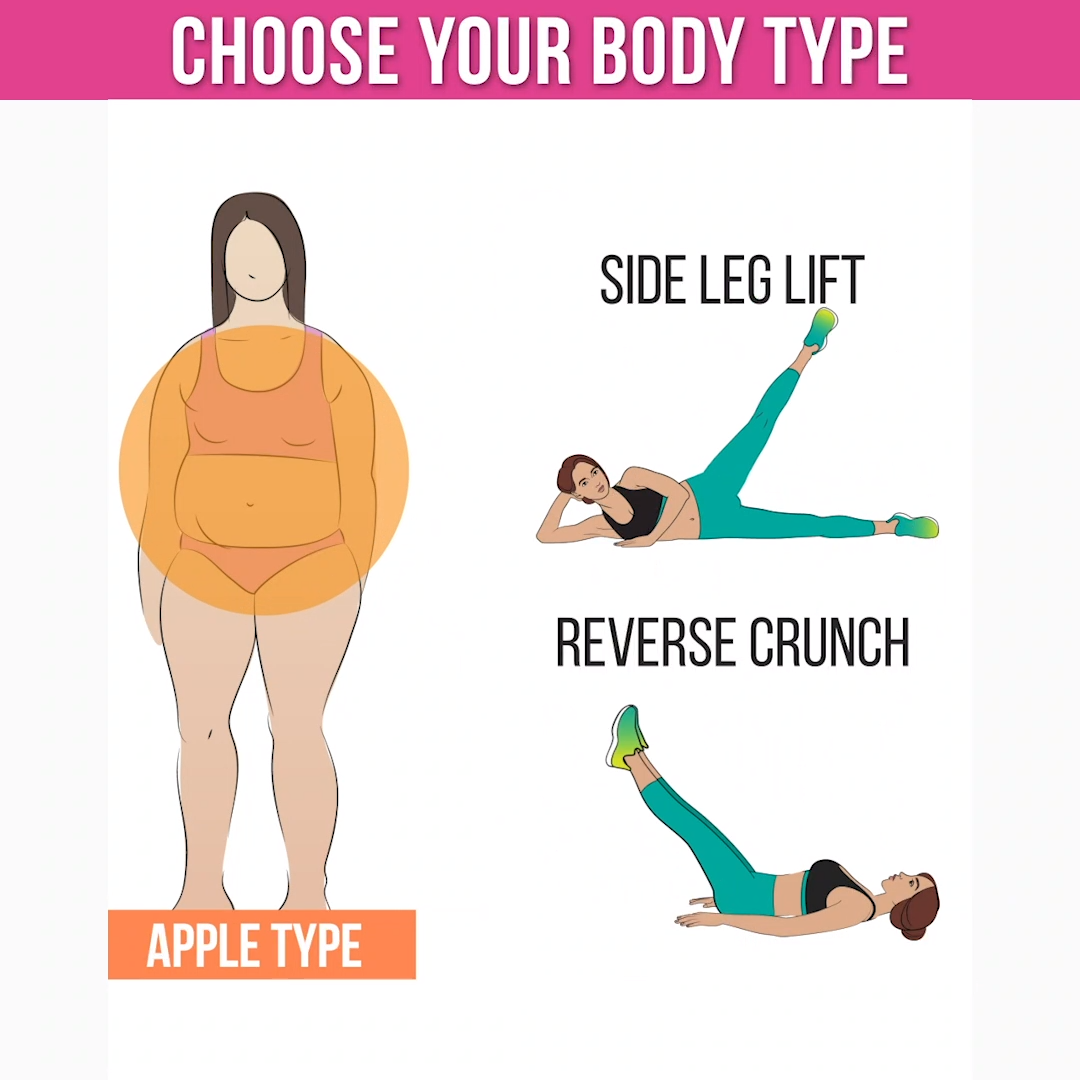
The Ectomorph Body Type: Characteristics and Dietary Needs
Ectomorphs are characterized by their lean, long limbs and smaller bone structure. They often have narrow shoulders and hips, with a naturally low body fat percentage. What makes ectomorphs unique in terms of metabolism?
Ectomorphs typically have a fast metabolism, making it challenging for them to gain weight or build muscle mass. This body type often struggles to put on weight despite consuming large amounts of food. How should ectomorphs approach their diet to support their goals?
- Focus on nutrient-dense, calorie-rich foods
- Increase protein intake to support muscle growth
- Consume complex carbohydrates for sustained energy
- Include healthy fats to boost calorie intake
What exercise routine is best suited for ectomorphs? A combination of resistance training and moderate cardio can help build muscle mass while maintaining overall health. Ectomorphs should prioritize strength training to promote muscle growth and bone density.

Mesomorph Body Type: Athletic Build and Balanced Metabolism
Mesomorphs are often described as having an athletic or muscular build. They tend to have broad shoulders, a narrow waist, and a more rectangular body shape. What sets mesomorphs apart in terms of physical characteristics?
- Naturally muscular physique
- Ability to gain muscle and lose fat relatively easily
- Balanced metabolism
- Responsive to both strength training and cardio exercises
How should mesomorphs approach their diet? A balanced approach is key for this body type. Mesomorphs benefit from a diet that includes:
- Moderate protein intake to support muscle maintenance and growth
- Complex carbohydrates for energy and recovery
- Healthy fats for hormone balance and satiety
- Plenty of fruits and vegetables for micronutrients
What exercise routine works best for mesomorphs? A mix of strength training and cardiovascular exercise can help mesomorphs maintain their athletic build while improving overall fitness. High-intensity interval training (HIIT) can be particularly effective for this body type.
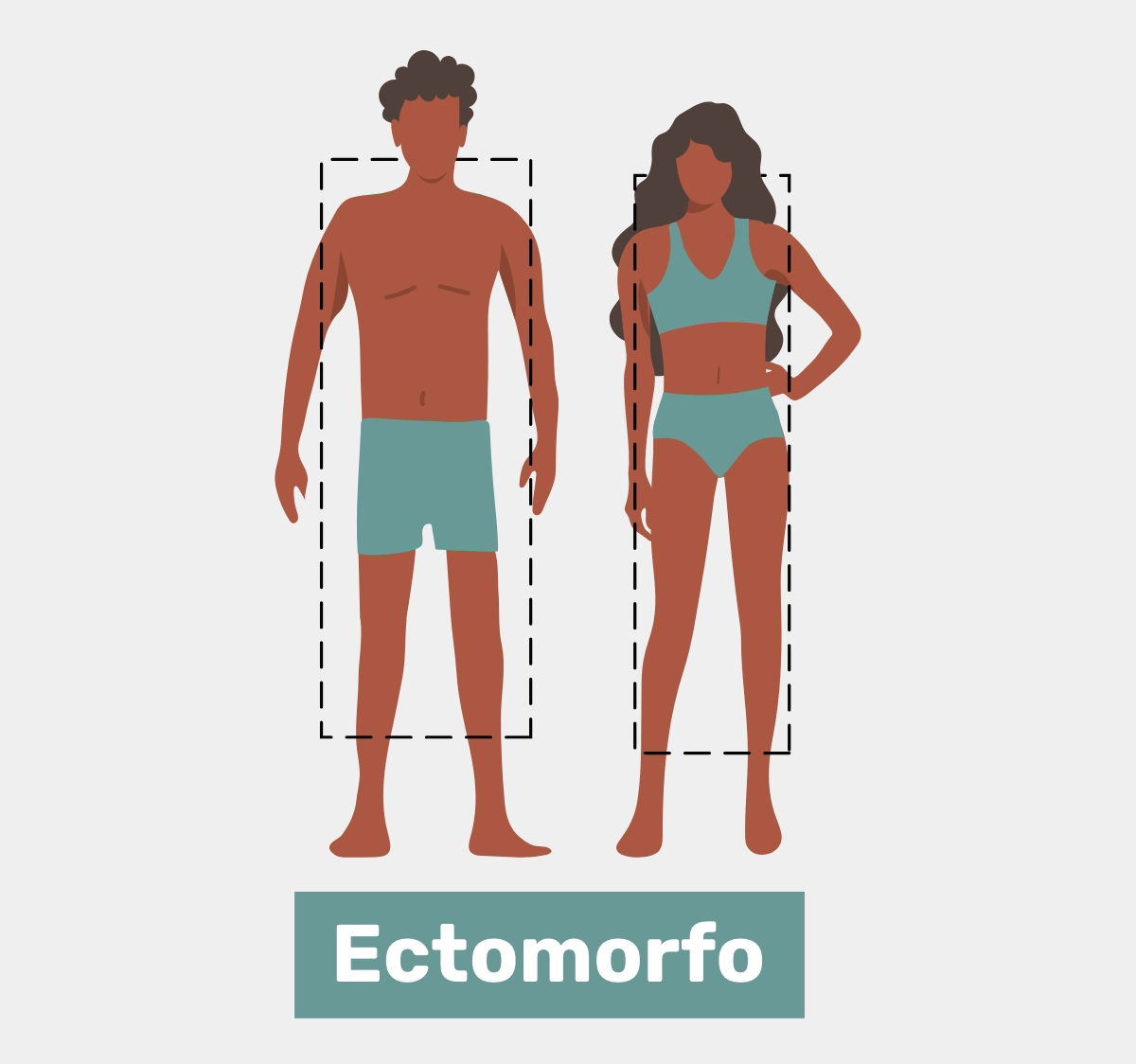
Endomorph Body Type: Curvy Build and Slower Metabolism
Endomorphs typically have a larger bone structure with wider hips and a tendency to store body fat more easily. What are the defining characteristics of the endomorph body type?
- Curvy or stocky build
- Slower metabolism
- Tendency to gain weight more easily
- Often pear-shaped (wider hips and thighs)
How should endomorphs approach their diet to support weight management and overall health? Endomorphs may benefit from a nutrition plan that emphasizes:
- Higher protein intake to support muscle mass and promote satiety
- Moderate to low carbohydrate consumption, focusing on complex carbs
- Healthy fats in moderation
- Plenty of fiber-rich vegetables to support digestion and fullness
What exercise routine is most effective for endomorphs? A combination of regular cardiovascular exercise and strength training can help boost metabolism and support weight management. Endomorphs may find success with:
- High-intensity interval training (HIIT) for fat burning
- Regular strength training to build muscle and increase metabolic rate
- Low-impact cardio activities like swimming or cycling
The Science Behind Body Type Diets: Research and Limitations
While the concept of body type diets has gained popularity, it’s important to examine the scientific evidence supporting these approaches. What does current research say about the relationship between somatotypes and dietary needs?
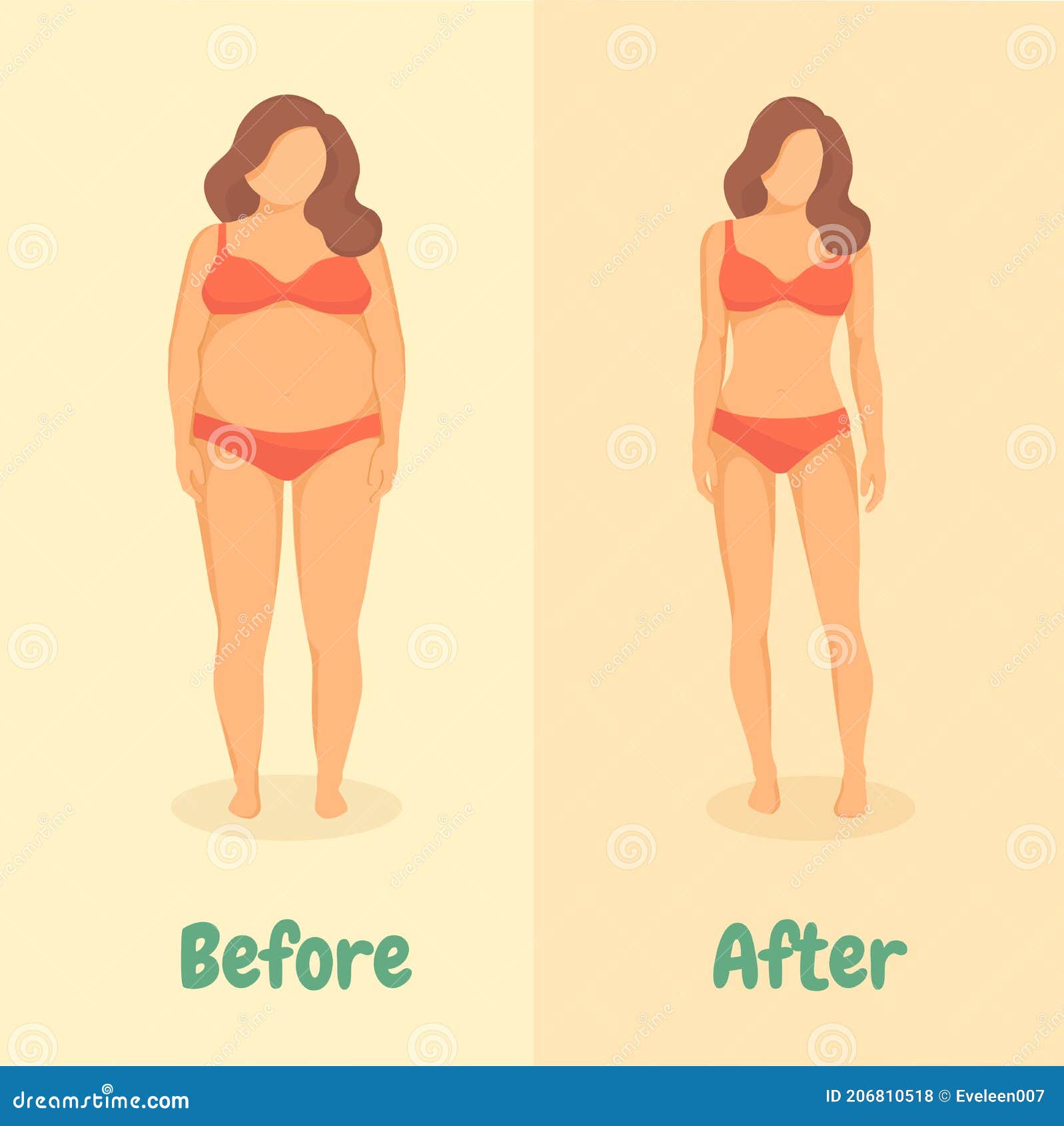
A small study involving 63 men aged 18 to 40 found that those with ectomorphic characteristics indeed had lower body fat percentages and weighed less compared to those with endomorphic traits. Another study analyzing food diaries of nearly 150 women over 57 years old revealed some interesting correlations:
- Endomorphic individuals consumed more protein on average
- Ectomorphic participants had the lowest protein intake
- Endomorphic women had higher diastolic blood pressure compared to ectomorphic and mesomorphic participants
However, it’s crucial to note that these studies have limitations, including small sample sizes and potential confounding factors. More comprehensive research is needed to fully validate the efficacy of body type-specific diets.
Tailoring Your Fitness Routine to Your Body Type
Understanding your body type can help inform your exercise choices and set realistic fitness goals. How can you optimize your workout routine based on your somatotype?
Ectomorph Fitness Recommendations
- Focus on compound exercises to build overall muscle mass
- Incorporate progressive overload in strength training
- Limit excessive cardio to avoid burning too many calories
- Allow for adequate rest and recovery between workouts
Mesomorph Fitness Recommendations
- Combine strength training with high-intensity interval training
- Experiment with various workout styles to keep challenging the body
- Include both hypertrophy and strength-focused training cycles
- Incorporate regular flexibility work to maintain mobility
Endomorph Fitness Recommendations
- Prioritize regular cardiovascular exercise for weight management
- Include strength training to boost metabolism and build lean muscle
- Focus on full-body workouts for maximum calorie burn
- Consider low-impact activities to protect joints
Remember that these recommendations are general guidelines. It’s essential to listen to your body and adjust your routine as needed.

Hybrid Body Types: Navigating the In-Between
While the three main somatotypes provide a useful framework, many individuals find themselves falling between categories. How can you determine if you have a hybrid body type?
Hybrid body types often exhibit characteristics of two somatotypes. Common combinations include:
- Ecto-mesomorph: Lean but with some muscular definition
- Meso-endomorph: Muscular build with a tendency to store fat
- Ecto-endomorph: Thin limbs with more fat storage in the midsection
If you identify with a hybrid body type, how should you approach your diet and exercise routine? The key is to create a balanced plan that addresses the characteristics of both types. For example, an ecto-mesomorph might focus on building muscle mass while maintaining a lean physique through a combination of strength training and strategic nutrition.
Beyond Body Types: Individual Factors Affecting Nutrition and Fitness
While understanding your body type can be helpful, it’s crucial to recognize that numerous other factors influence your nutritional needs and fitness outcomes. What are some important considerations beyond somatotype?

- Genetic predispositions
- Hormonal balance
- Age and life stage (e.g., pregnancy, menopause)
- Lifestyle factors (stress, sleep quality, activity level)
- Medical conditions and medications
- Personal goals and preferences
How can you create a holistic approach to health that considers both your body type and individual factors? Working with healthcare professionals, such as registered dietitians and certified fitness trainers, can help you develop a personalized plan that takes all these elements into account.
Practical Tips for Implementing a Body Type-Based Approach
If you’re interested in exploring how your body type might inform your health and fitness journey, consider these practical steps:
- Assess your body type: Look at your natural build and how your body responds to different diets and exercise routines.
- Set realistic goals: Use your body type insights to establish achievable targets for weight, muscle gain, or performance.
- Experiment with nutrition: Try adjusting your macronutrient ratios based on your somatotype’s general recommendations.
- Adapt your workouts: Incorporate exercises that align with your body type’s strengths and challenges.
- Track progress: Keep a journal of your food intake, workouts, and how you feel to identify what works best for you.
- Be flexible: Remember that body type is just one factor – be willing to adjust your approach based on your individual response and changing needs.
How can you maintain a balanced perspective when implementing a body type-based approach? It’s essential to focus on overall health and well-being rather than striving for an idealized body shape. Embrace your unique physique and use body type insights as a tool for optimization, not limitation.
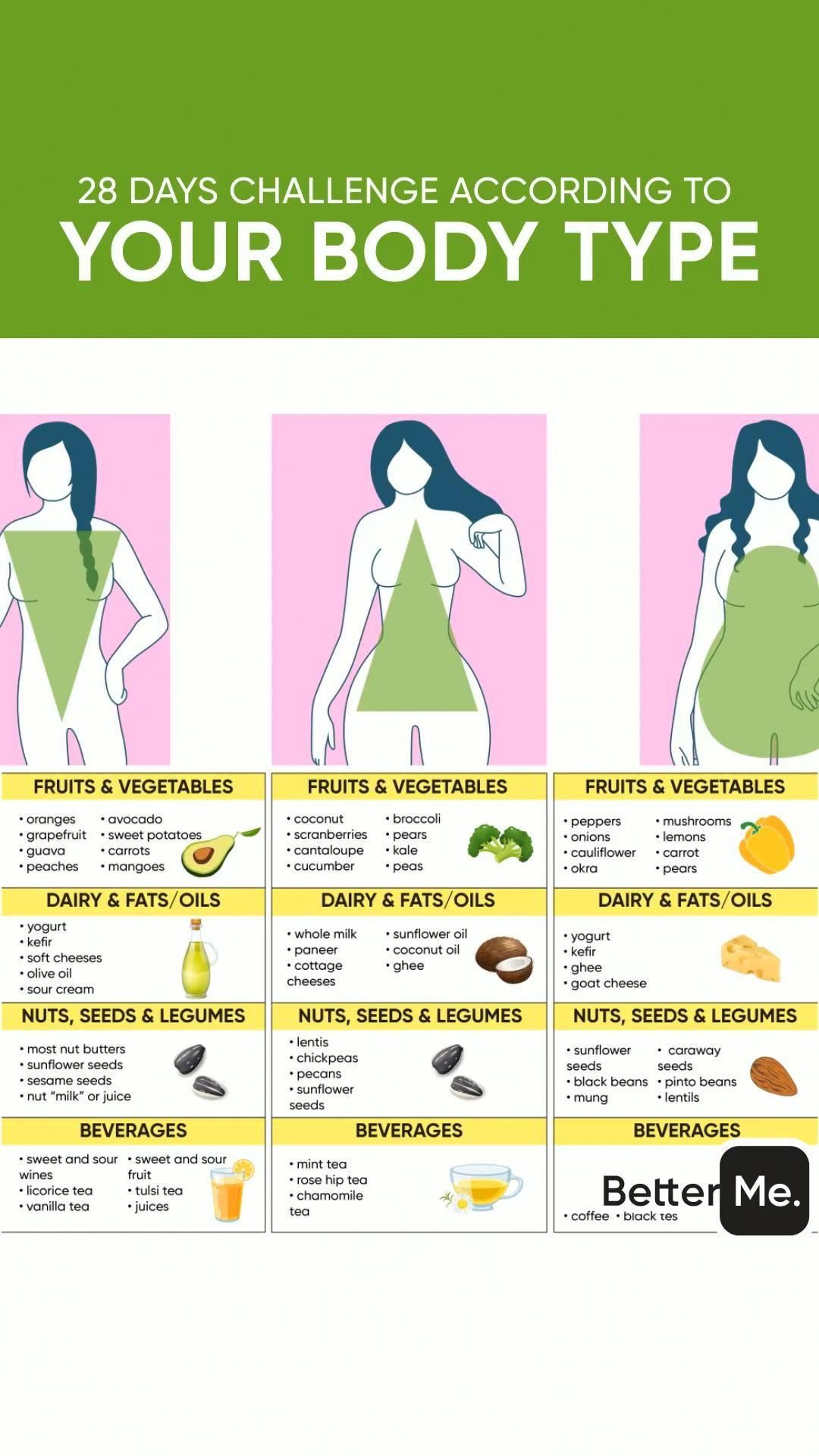
The Role of Mindset in Body Type Diets
While understanding your body type can be informative, it’s crucial to maintain a healthy mindset throughout your fitness journey. How can you use body type knowledge without falling into restrictive or negative thought patterns?
- Focus on health and performance rather than appearance
- Celebrate your body’s unique strengths and capabilities
- Avoid comparing yourself to others with different body types
- Recognize that your body may change over time due to various factors
- Practice self-compassion and patience in your health journey
What strategies can help you maintain a positive body image while working towards your health goals? Consider incorporating mindfulness practices, surrounding yourself with supportive individuals, and regularly acknowledging your progress and achievements, regardless of your body type.
Remember that the goal of understanding your body type is to optimize your approach to health and fitness, not to limit or define you. By combining body type insights with individual factors and a positive mindset, you can create a sustainable, enjoyable approach to nutrition and exercise that supports your overall well-being.

Body Type Diet: Are You an Ectomorph, Mesomorph, or Endomorph?
By Jessica MigalaMedically Reviewed by Kelly Kennedy, RDN
Reviewed:
Medically Reviewed
The shape of your body can inform your choice of the right diet, say proponents of the body type diet.Marina Skobliakova/iStock
Without judgment, look into the mirror. What do you see? Do you see long, lanky limbs? Wide hips and a bit of belly? A sporty, muscular body? Knowing where you fit in (or if a single body “type” doesn’t describe you) could help you determine the best diet and exercise plan for you, some healthcare professionals argue. This is what’s called the body type diet.
What Is Eating for Your Body Type?
Proponents of this plan say your body type can give you clues about your metabolism and hormones, and thus how well you process carbohydrates and how much protein you need. Not to mention, it may tell you whether you’d be your healthiest, most energized version of yourself by, say, signing up for that 5K you’ve been eyeing or opting instead for strength training at your local CrossFit gym.
Some research suggests that each body type has certain characteristics in terms of weight, fat, and muscle — but there’s less data to support the dietary and exercise recommendations, so don’t expect this to be a magic bullet.
How Does the Body Type Diet Work?
If you’ve been eating a nutritious diet and exercising, you still may not be getting the results you’re looking for. “Many people are exercising for the first time ever and eating cleaner than ever, but they’re still doing the wrong thing for their body,” says Phil Catudal, a celebrity trainer and the coauthor of Just Your Type: The Ultimate Guide to Eating and Training Right for Your Body Type with the health journalist Stacey Colino.
The idea that everyone has a body type comes from William Herbert Sheldon, MD, PhD, the late psychologist who developed what are called “somatotypes” in the 1940s.
“He was trying to explain personality types based on one’s physiological structure,” says Catudal. The problem is, though research shows that people make judgments about personality based on people’s body features, linking personality traits with body type gets problematic (and bogged down in bias and stigma) quickly.
The problem is, though research shows that people make judgments about personality based on people’s body features, linking personality traits with body type gets problematic (and bogged down in bias and stigma) quickly.
“He stumbled upon something great with body types, but the personality stuff is a disconnect,” Catudal says.
When it comes to your body, Catudal says there are common elements among body types that suggests how much muscle or fat you tend to have, as well as how fast or slow your metabolism may be, and thus how easy or difficult it may be for you to lose weight.
There isn’t a ton of research on how a person’s somatotype might better inform their diet and exercise habits. But there is some data on body composition differences. One small study looked at 63 men ages 18 to 40. The researchers found that those whose bodies were long and lean indeed had less body fat, weighed less, and had less lean body mass compared with those who had curvy or hourglass figures.
A more recent paper analyzed three-day food diaries of nearly 150 women over age 57.
They concluded that somatotype was related to factors like dieting, physical activity, weight cycling, body mass index (BMI), and even disease status. Those with curvy figures had greater diastolic blood pressure compared with lean and lanky participants, as well as those who had an hourglass figure. Women who were lean and lanky were also more likely to be underweight. When researchers looked at their dietary intake, they found that curvy individuals consumed more protein and those who were lean consumed the least on average.
Catudal says that finding your dominant body type (because you can be a mix of two) can help guide you toward healthy habits that will work best for your body and help you form more realistic goals. “If you’re doing the same thing as someone else who doesn’t have your same body structure, you won’t get the same results. It helps to realign your expectations with what is possible for you,” he says.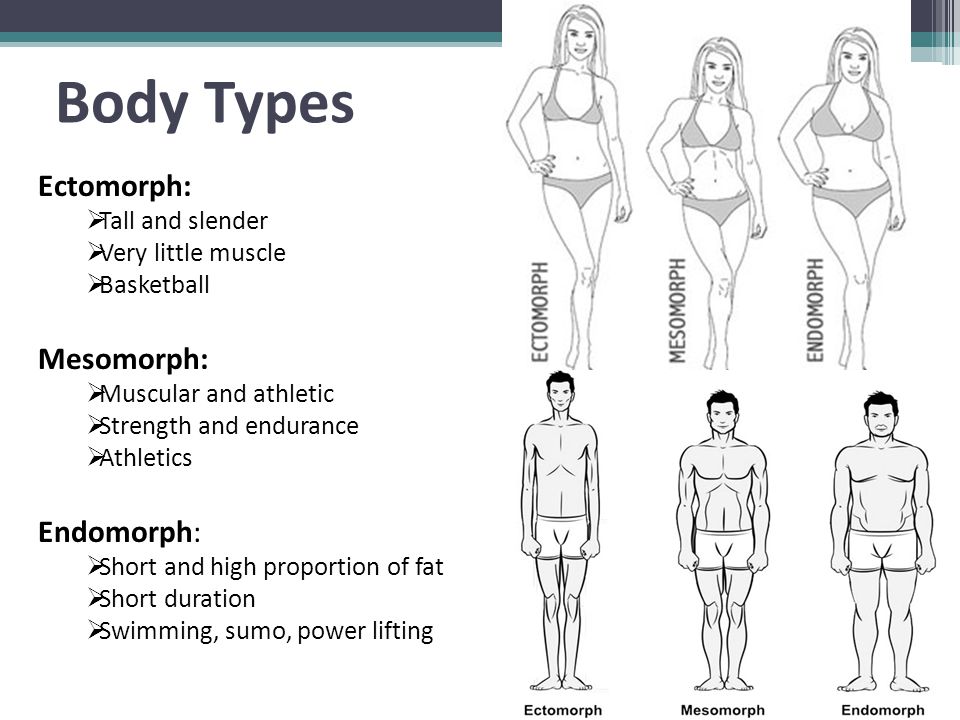
The Body Types and How to Know Your Type
There are three main body types, says Catudal. Daily exercise, diet habits, and even metabolic changes by way of pregnancy and menopause can skew your body type, so you may not recognize yours right away. Lifestyle factors may have also changed your body, so that you now are more of a hybrid type.
If you’re unclear about where yours falls, one clue to your body’s more natural metabolic state is what your body looked like when you were a late teen or in your early twenties, says Catudal. Here are some other clues, from Just Your Type, to identify your category.
Ectomorph Thin, long, and lanky. You have a smaller bone structure with shoulders that tend to be narrower than your hips. Over the years, you may also notice you have trouble gaining weight. This type can typically handle more carbohydrates.
Mesomorph You’re more muscle-dominant, with an hourglass figure and medium frame.
Endomorph You tend to have more body fat than the other body types in this framework. Catudal says that women who are endomorphs may be described as curvaceous, while men may be called stocky. You tend to carry weight in your belly, hips, and thighs. An endomorph may be more prone to insulin resistance, and thus they need to watch their carbohydrate intake. Insulin resistance happens when cells can’t effectively take glucose from your blood and your pancreas compensates by ramping up insulin production, and it is the hallmark of type 2 diabetes.
That said, “many people misclassify their body type,” says Catudal. His book includes a quiz to help you identify if you fit neatly into one of the three main types above, or a hybrid type, described below. (To figure out your body type, take the quiz here.)
Ecto-Mesomorphs This body type is lean and muscular.
Meso-Endomorphs This person is strong but the muscles aren’t well defined, as in a football player.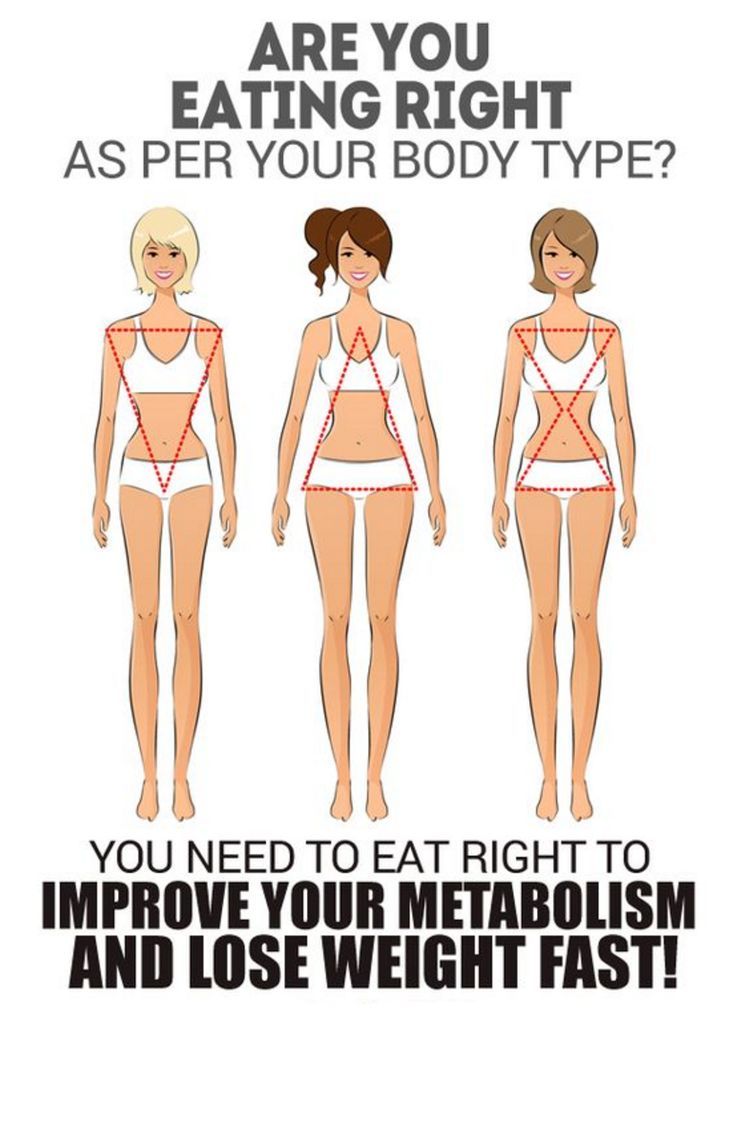 But you don’t need to be a football player to have this body type — in fact, it’s more common than you may think. In a past review on 774 adults, the most common somatotype in men and women was a combination of endomorph and mesomorph.
But you don’t need to be a football player to have this body type — in fact, it’s more common than you may think. In a past review on 774 adults, the most common somatotype in men and women was a combination of endomorph and mesomorph.
Ecto-Endomorphs This describes a person who is naturally thin but has gained weight due to lack of exercise and a poor diet.
What to Eat, According to Your Body Type
Most of the foods recommended are whole, nutrient-dense sources of carbohydrates, protein, and healthy fats, and are similar for each diet. Where they differ is in their macronutrient ratios, with some foods considered better suited for certain body types. For instance, an endomorph probably wouldn’t eat oatmeal, because the thinking goes that this body type is better off eating fewer carbs. Instead, they’d opt for a protein-rich breakfast, such as eggs.
Sample Food Menus for Each Body Type
A 1-Day Sample Menu for Ectomorphs
In terms of macronutrients (carbs, protein, fat), Catudal suggests that ectomorphs eat a 45-35-20 split of carbohydrates, protein, and fat.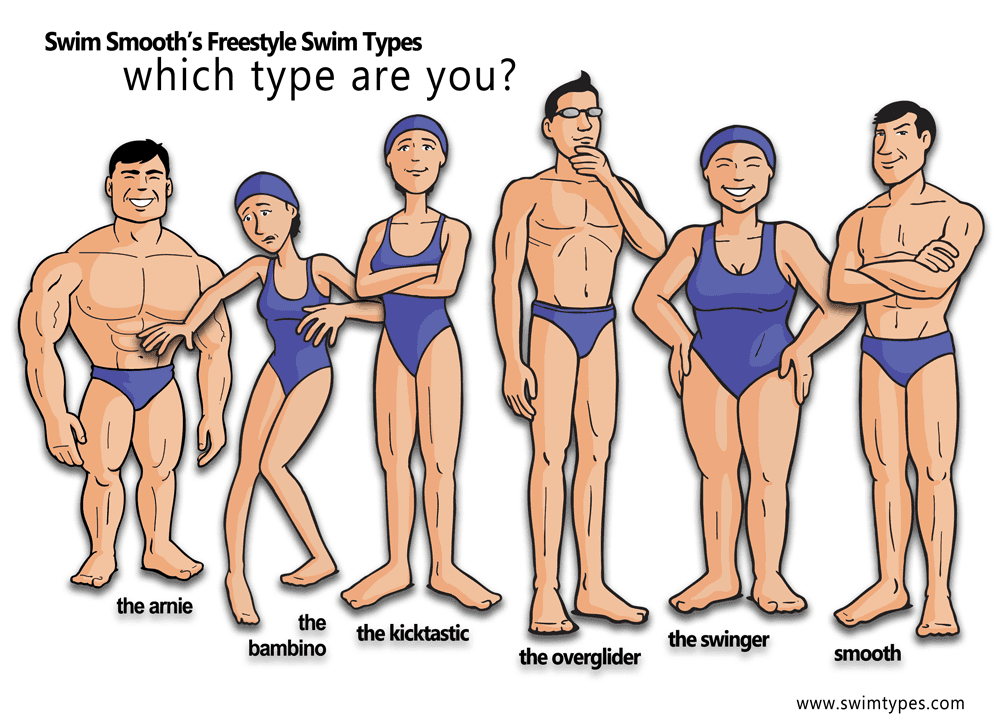 This means you’ll be eating a moderate protein, lower fat, and higher carbohydrate diet compared with the other diets.
This means you’ll be eating a moderate protein, lower fat, and higher carbohydrate diet compared with the other diets.
Breakfast Oatmeal with fruit and nuts
Snack Protein shake
Lunch Salad with a variety of chopped veggies, topped with chicken and vinaigrette
Snack Apple and almonds
Dinner Grilled shrimp and broccoli over quinoa
A 1-Day Sample Menu for Mesomorphs
A mesomorph will aim to divide their calories fairly evenly between the macronutrients, Catudal says.
Breakfast Toast with scrambled eggs
Snack Protein bar and fruit
Lunch Salad with mixed chopped veggies, chickpeas, and your choice of dressing
Snack Veggies and hummus
Dinner Chicken breast, roasted veggies, sweet potato
A 1-Day Sample Menu for Endomorphs
The endomorph will want to stick with a 20-40-40 split of calories between carbohydrates, protein, and fat in order to shed body fat, says Catudal. (Read: High protein, lower in carbs.) Consume grains with lunch or dinner, depending on the time of your workout, he advises.
(Read: High protein, lower in carbs.) Consume grains with lunch or dinner, depending on the time of your workout, he advises.
Breakfast Eggs and spinach
Snack Protein bar
Lunch Roasted turkey lettuce wraps
Snack Veggies and hummus
Dinner Chicken with zucchini noodles and quinoa
Advantages of Following a Body Type Diet
Learning about your somatotype and where you fall can help you determine the nutrient intake that will fuel your body best, and, if it’s your goal, so you’ll lose weight more effectively, says Catudal. The body type diet isn’t unhealthy, which is another plus, and importantly it may steer you away from more extreme diets that will, at best, not work, and at worst, backfire.
There’s still an eating prescription involved, though. Ectomorphs, for example, are thought to excel on a higher-carbohydrate eating plan, so an extremely low-carb keto diet may set them up for failure. It’s one reason why the latest diet isn’t guaranteed to give you the same results as your friend who tried the same plan.
It’s one reason why the latest diet isn’t guaranteed to give you the same results as your friend who tried the same plan.
You’ll also get a reality check on your goals. Though anyone can give their birth body type a dramatic shift, it depends on how much time and effort you’re looking to put in, says Catudal. You may be striving for defined abs now, but that may not be right for your body — and that’s okay. Despite what popular culture may have you believe, there’s no “perfect” diet, and improving your health is what matters.
Another benefit to working with your body type is that it can help you “understand how to maximize your potential and not get frustrated by your limitations,” says Marta Montenegro, PhD, a certified strength and conditioning specialist and a specialist in fitness nutrition in Miami. For instance, endomorphs tend to have a more difficult time losing weight. Knowing this ahead of time can help prime you to put in the work needed or tweak your diet accordingly (by reducing carbs), she says. There is often a lot of frustration involved in weight loss, and knowing your body type can help you set expectations appropriately.
There is often a lot of frustration involved in weight loss, and knowing your body type can help you set expectations appropriately.
Disadvantages of the Body Type Diet
Many experts say there isn’t enough data to support a body type diet. “There’s just no research out there on using your somatotype to define your diet,” says Melina Jampolis, MD, an internist and board-certified physician nutrition specialist in Valley Village, California. While it may point to how easily you can lose weight (naturally thin ectomorphs and more muscular mesomorphs will likely have an easier time because of their supposed healthier insulin function), she says, “in terms of body type, the only type that matters for your diet is whether you’re an apple or a pear.”
“Pears” have a smaller waist compared with their larger hips and thighs. “Apples” have a larger midsection — defined as a waistline of more than 35 inches for women and 40 inches for men — which is associated with a greater risk of metabolic syndrome.
“When you carry weight around your belly, you’re likely less responsive to insulin compared with someone who carries weight more diffusely throughout their body,” says Dr. Jampolis.
On this plan, apple types would be advised to limit grains and starchy carbs to help improve insulin sensitivity. This is true no matter how you’d describe yourself, she says, adding that even ectomorphs who have a bigger belly are at risk for health problems.
Also consider that many people don’t fit into a neat little organization system of body types, says Nanci Guest, PhD, RD, CSCS, a nutritional scientist, genetic researcher, and personal trainer in Toronto. “People exist in between each one of the body types — we come in every shape out there. There are so many exceptions to the rule [of who fits into what somatotype] that after that, this isn’t a rule anymore,” she says.
Dr. Guest also notes that there isn’t enough science to suggest that you can exercise for your type. “We don’t know if you should do the opposite [of your strengths] to balance yourself out or do what you’re good at to capitalize on your abilities. It’s not yet clear how to train people based on their body type,” she says.
It’s not yet clear how to train people based on their body type,” she says.
How to Work Out According to Your Specific Body Type
In addition to food choices, the body type diet advises letting your somatotype guide you toward the ideal workout. One caveat: “This doesn’t mean you should limit yourself. These may be the things that you’re good at, but we don’t want to stop people from doing things they love,” says Catudal.
Ectomorph You may find you gravitate toward endurance sports, like running, but that adding resistance training (such as weight lifting or body weight exercises) can help you build toned, lean muscles and lower your injury risk. High intensity interval training (HIIT) is effective because it trains both your anaerobic and aerobic cardio systems, as well as building strength and muscle.
Mesomorph You tend to build muscle easily, and sports that require quick bursts of strength and power (like soccer or hockey) tend to come easy.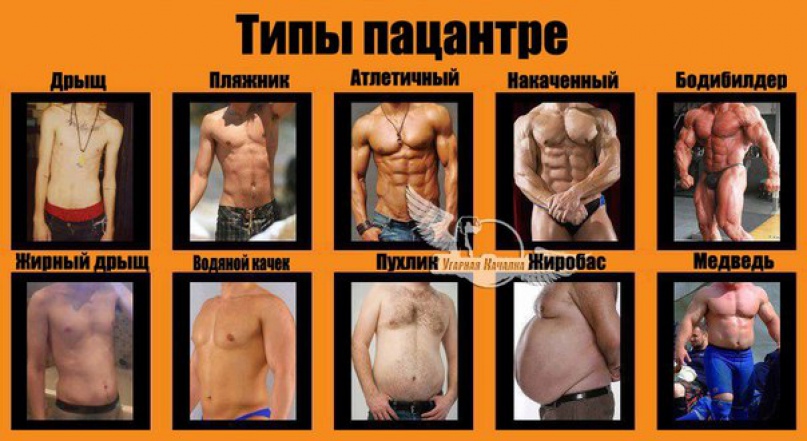 But it’s also easy for you to hit fitness plateaus. Keep in mind that varying your workouts, doing workouts of different intensity (like HIIT training, sprints, or kickboxing), and changing your workout routine every few months can all help to avoid those plateaus and keep you in your best shape, Catudal says.
But it’s also easy for you to hit fitness plateaus. Keep in mind that varying your workouts, doing workouts of different intensity (like HIIT training, sprints, or kickboxing), and changing your workout routine every few months can all help to avoid those plateaus and keep you in your best shape, Catudal says.
Endomorph Adding HIIT workouts to your training routine once stamina and endurance increase is a great way to stimulate extra fat burning that continues even after your workouts.
Resources We Love: Body Type Diet
Just Your Type: The Ultimate Guide to Eating and Training Right for Your Body Type
By Phil Catudal, with Stacey Colino
This book shines at explaining the basics of body type diet and exercise with a kind and thoughtful tone. You’ll feel empowered to adopt habits that are right for your body without feeling as if you’re limited by your “type.”
What Is Eating for Your Body Type?
By Helen Kollias, PhD, and Ryan Andrews, RD, CSCS
Precision Nutrition is a company that certifies health and fitness professionals, and their experts are excellent resources for breaking down diet trends in an honest way. Andrews and Dr. Kollias offer tips on how to try a body type diet in a healthful, sustainable way.
Andrews and Dr. Kollias offer tips on how to try a body type diet in a healthful, sustainable way.
How to Eat for Your Body Type, Ep. 135
Open Sky Fitness Podcast
Sometimes, it’s easier to listen while you learn, and this podcast is a good intro to body types and helps answer common questions, such as how can you gain muscle if you’re an ectomorph and how an endomorph can get stronger to stoke their metabolism.
How to Lose Weight Based on Your Body Type, Ep. 35
Jacked on the Beanstalk
If weight loss is your main goal with the body type diet, this podcast breaks down how calorie, protein, and fat intake goals vary for each body type. (That said, always consult with an RD for the most personalized calculations.)
Should You Follow a Body Type Diet?
If you’re looking for a new way to approach a diet and exercise program, following your somatotype may be a way to maximize your body’s strengths and correct any weaknesses. That said, experts do not agree across the board that the scientific data supports following this type of program. The upshot is that it is safe because it generally focuses on nutrient-rich whole foods, is balanced, and doesn’t eliminate any one food group.
That said, experts do not agree across the board that the scientific data supports following this type of program. The upshot is that it is safe because it generally focuses on nutrient-rich whole foods, is balanced, and doesn’t eliminate any one food group.
Editorial Sources and Fact-Checking
- William Sheldon. Encyclopaedia Britannica.
- Bolonchuk WW, Siders WA, Lykken GI, et al. Association of Dominant Somatotype of Men With Body Structure, Function During Exercise, and Nutritional Assessment. American Journal of Human Biology. March 2000.
- Drywien ME, Frackiewicz J, Gornicka M, et al. Somatotype, Diet, and Nutritional Status of Women. Anthropological Review. October 2017.
- Insulin Resistance and Prediabetes. National Institute of Diabetes and Digestive and Kidney Diseases. May 2018.
- About Metabolic Syndrome. American Heart Association. July 2016.
- Koleva M, Nacheva A, Boev M. Somatoype and Disease Prevalence in Adults.
 Reviews on Environmental Health. January–March 2002.
Reviews on Environmental Health. January–March 2002. - Hu Y, Parde CJ, Hill MQ, et al. First Impressions of Personality Traits From Body Shapes. Psychological Science. October 22, 2018.
Show Less
By subscribing you agree to the Terms of Use and Privacy Policy.
10 Easy Recipes to Whip Up With a Block of Tofu
Have a block of tofu? Well, you’re on your way to a quick, nutritious dinner. Tofu is a source of plant-based protein, and you can enjoy this versatile…
By Lauren Bedosky
12 Scientific Health Benefits of Turmeric and Curcumin
From diabetes and depression treatment to heart disease and cancer prevention, there’s no shortage of health claims about curcumin, turmeric’s active …
By Lauren Bedosky
All About Jackfruit: Nutrition, Benefits, Weight Loss Effect, Recipes, and More
This versatile fruit is often used as a substitute for pulled meat, especially in plant-based diets. Read on to learn about its health benefits, nutritional…
Read on to learn about its health benefits, nutritional…
By Moira Lawler
6 Expert Tips for Reducing Added Sugar in Your Diet
Ditching added sugar can aid weight loss and heart health. And with these strategies, endorsed by registered dietitians and Dr. Jennifer Ashton, the task…
By Jessica Migala
Are Sports Drinks Really Good for You?
Sports drinks are a multi-billion dollar industry, but are they actually a healthy beverage choice? In spite of their claims, many contain added sugar…
By Lacey Muinos
8 Ways to Get the Most Out of Probiotic Supplements
Probiotic supplements work most effectively when you follow some key principles. Find out how to take probiotics so you reap all of their benefits.
By Erica Patino
Best After-School Snacks for Kids
Looking for ideas beyond cheese and crackers? Break out of your after-school snack rut with these healthy, yummy foods that your kids will love.
By Katherine Lee
Corn 101: A Complete Guide
Corn can be considered both a vegetable and a grain, but tends to be regarded as less healthy than other whole, plant-based foods. This guide will explain…
By Stephanie Thurrott
9 Ways to Eat More Probiotics Every Day
Probiotics — those good-for-you live bacteria and yeasts — have been found to support a healthy gut and may even help treat some digestive problems. Here…
By Lambeth Hochwald
How to Exercise if You Have an Mesomorph Body Type
How do you know if you have a mesomorph body type? You might love Tabata and other high-intensity interval training (HIIT) workouts, but find long bouts of cardio arduous. You may naturally enjoy the weight room because that’s where your strengths — no pun intended — lie.
“A mesomorph is generally defined as someone who has a body type that has a high level of muscle and strength,” says Adam Feit, the head strength and sports psychology coach for Precision Nutrition in Springfield, Massachusetts. Now, perhaps you don’t have lots of muscle at the moment because you’ve been inactive for a while. But you know if you did start working out, you would gain muscle relatively easily.
Football players (think linebackers, cornerbacks, and running backs) and gymnasts often have mesomorph body types, as muscle and power tend to allow these athletes to be more successful in their sports. Non-professional-athlete mesomorphs may notice that they can build muscle with a weight-focused strength routine easily, but they’re also likely to gain weight or fat.
The other main body types, also called somatotypes, are ectomorph (long and lanky) and endomorph (curvy). Somatotype theory builds on work from the mid-20th century by the psychologist William Sheldon, who defined these body types. Much of Sheldon’s work linking these body types to various personality traits was debunked, according to the National Academy of Sports Medicine. And there’s still not a large amount of evidence behind the diet and exercise recommendations for the various body types, but some data does suggest that eating and exercise can have different effects on people with different body types — and that learning your body type can help you address deficits in your strength, cardio, or flexibility.
Much of Sheldon’s work linking these body types to various personality traits was debunked, according to the National Academy of Sports Medicine. And there’s still not a large amount of evidence behind the diet and exercise recommendations for the various body types, but some data does suggest that eating and exercise can have different effects on people with different body types — and that learning your body type can help you address deficits in your strength, cardio, or flexibility.
RELATED: Everything You Need to Know About Working Out, Including How to Get Started
While some people are strictly one body type or another, many are combinations of these three somatotypes, Feit says. Some people may even notice differences among different muscle groups. For instance, you can easily build muscle and bulk up in your legs and glutes (mesomorph body type tendency), but you really struggle to build upper body strength (ectomorph body type tendency). For that reason, there isn’t one guideline that will work for everyone who identifies fully or, in part, as a mesomorph. “I encourage you not to allow these basic categories to become a rule you must follow,” he says.
For that reason, there isn’t one guideline that will work for everyone who identifies fully or, in part, as a mesomorph. “I encourage you not to allow these basic categories to become a rule you must follow,” he says.
If you do have a mesomorph body type, you may find that these training tips will help you reap the exercise gains you seek.
What Types of Exercises Should You Do if You Have a Mesomorph Body Type?
For people who build muscle readily, they may find that they gravitate toward the activity that they’re good at: strength training. That’s according to American College of Sports Medicine fellow Stuart Phillips, PhD, a professor, the director of the Physical Activity Centre of Excellence, and the director of the McMaster Centre for Nutrition, Exercise and Health Research at McMaster University in Hamilton Ontario. Dr. Phillips says he mostly identifies with the mesomorph body type, and, while it doesn’t resolve everything, knowing his type did give him some insight on what works best for him.
“After running marathons, I realized I wasn’t made to pound up and down pavement. I tailor activities to what I enjoy and that feel better naturally, which is weight lifting,” he says.
But while people with mesomorph body types may see the most progress after weight and strength-training sessions, it’s important not to forgo other types of exercise.
Do diversify your workouts and include cardio. “If you’ve just been weight lifting, take a day to do body weight exercises and spend a day on cardio to challenge your heart and respiratory system for endurance,” says Katrina Pilkington, a NASM-certified personal trainer based in Sacramento. It’s not a call to run every day, but do focus on your heart (via cardiovascular or aerobic exercise) sometimes rather than just your muscles, she says.
Also get in flexibility or mobility training. “Flexibility is all about recovery and making sure muscles can perform to their optimum ability,” says Pilkington. She favors vibration therapy to release tight muscles (use a power massager, for instance). Research published in the Journal of Clinical & Diagnostic Research found that vibration therapy can be effective for improving muscle recovery, power, strength, flexibility, and reducing post-exercise muscle soreness.
Research published in the Journal of Clinical & Diagnostic Research found that vibration therapy can be effective for improving muscle recovery, power, strength, flexibility, and reducing post-exercise muscle soreness.
If that’s not available to you (these devices can be an investment), static stretching post-exercise is another good option, says Pilkington.
“If you do not take care of your tendons and muscles, you’ll hit a wall in training and may also get injured,” she says. Try stretches like the quad stretch (where you stand and bring one heel up to your butt), a calf stretch, or lat stretch (facing a table, stretch both arms out straight on the table, then bend forward and push your shoulders down), Pilkington says.
RELATED: How Much Exercise Do You Really Need?
Common Mesomorph Exercise Mistakes — and How to Fix Them
- Skipping cardio If you’re continually in the weight room, you may be missing out on the cardiorespiratory side of a fitness routine.
 It’s not necessary to go through long bouts of cardio if you find it especially grueling. Instead, consider interval sprints or high intensity interval training (HIIT), which will get your heart rate up but can be done in much shorter periods of time, says Feit.
It’s not necessary to go through long bouts of cardio if you find it especially grueling. Instead, consider interval sprints or high intensity interval training (HIIT), which will get your heart rate up but can be done in much shorter periods of time, says Feit. - Getting stuck in an exercise rut Not enough variety in an exercise routine can be a problem for people of any body type, says Feit. For mesomorphs, it might look like always doing the same weight training routine or the same types of strength workouts. Cross-training with other activities will prevent mental burnout and lower the risk of injury. Broaden your scope of what “counts” as exercise. A long hike with your family — even if casual — can make your legs (and lungs) burn in different ways by forcing your body to recruit a range of muscles, including stabilizer muscles, rather than isolating them at the gym. Similarly, yoga and Pilates may not come naturally to you, but you may realize that an occasional practice makes your body feel really good.

- Not going after your exercise goals Maybe you decide that, in fact, you do want to train for a half or full marathon. Don’t let a boxier frame and more muscle dissuade you from signing up. (You may find that it’s not you, or you could discover you love it.) Never let naysayers tell you what you can and can’t excel at. “Your body type doesn’t define you,” says Feit. “While it might provide some basic guidelines about what will work for you, don’t let that dictate the exercise you pick,” he says.
Millions of Peloton Bikes Recalled for Injury Risk
Peloton issued the recall after receiving more than 30 reports of seat posts breaking during rides. Riders can receive a free replacement seat post.
By Monroe Hammond
6 Things You Need to Know About Exercising on the Keto Diet
How is going on the keto diet going to affect your exercise routine? For some workouts, performance may take a hit. But if you’re fueling the right way…
But if you’re fueling the right way…
By Michael Dolan
8 Ways to Sit Less and Move More Each Day
Hate to exercise? Just adding in easy activities — as simple as standing up and stretching — can make a significant difference to your weight and well…
By Wyatt Myers
How to Fit in More Steps Every Day
How many steps do you take each day? Higher daily step counts tend to be linked to a lot of health benefits, including overall mortality (meaning, yes…
By Elizabeth Millard
Running: What It Is, Health Benefits, How to Get Started, and How to Get Better
Running is a workout that can boost your heart health, bone health, mood, energy, and more. Here’s how to get started, how to get better, and how to avoid…
By Elizabeth Millard
8 Ways Strength Training Boosts Your Health and Fitness
Here’s why strength training is so good for your health and fitness, from stronger bones to boosting weight loss to helping you manage conditions like. ..
..
By Chris Iliades, MD
Is Strength Training Good for Weight Loss?
Resistance exercise may not burn as many calories as aerobic, but it can support weight loss in other ways. Here’s how.
By Lauren Bedosky
How to find out your body type: 4 ways
In the category:
Blog, Fitness
Add to Selected
In the article “Body Types: How Does Genetics Affect Your Figure?” I talked in detail about the characteristic features of ectomorphs, mesomorphs and endomorphs. In this article I will talk about how you can determine which somatotype you belong to.
There are several ways.
Measuring the circumference of the wrist
It is necessary to measure the wrist at the narrowest point with a measuring tape and compare with the data in the table.
| Body type (somatotype) | Wrist circumference (men) | Wrist circumference (women) |
|---|---|---|
| Ectomorph | less than 18 cm | less than 15 cm |
| Mesomorph | 18 to 20 | 15 to 17 |
| Endomorph | from 20 and more | 17 and over |
This method is the simplest, but its accuracy is very relative and today, some studies generally question the possibility of determining the somatotype by such parameters.
Determining the epigastric angle
The epigastric angle is the angle that forms between the 12th pair of ribs (the lowest pair). To determine it, go to the mirror, take a deep breath and hold your breath. Take two pencils and arrange them in such a way that their ends on one side meet at the junction of the lower ribs, and the pencils themselves are located along each of the ribs. The location of the pencils will clearly show you the size of the intercostal angle. By its value, you can determine your body type.
| Body type (somatotype) | Epigastric angle value ° |
|---|---|
| Ectomorph | less than 90° |
| Mesomorph | 90° |
| Endomorph | over 90° |
Determination of anthropometric indicators
Anthropometric indicators are age, sex, racial and other features of the physical structure that can be expressed quantitatively.
This method is the most accurate, but cannot be used alone. Such measurements can be carried out in medical centers, or in fitness rooms where there is special equipment.
Body type determination based on visual assessment
You can also roughly determine your body type simply by analyzing your appearance. And the best way to do this is to remember what kind of child you were as a child. If thin and tall, then most likely you are an ectomorph. If even in childhood they were overweight, then it is more likely that an endomorph. But do not forget about the objective factors that could affect this. So, if you were “fed for three” as a child, then the reason for excess weight is most likely precisely in this, and not in the somatotype.
Why do you need to know your body type?
In order to rely on this data when choosing the right nutrition and training regimen. For different body types, nutrition recommendations and training strategies can be very different, even if the goals are the same.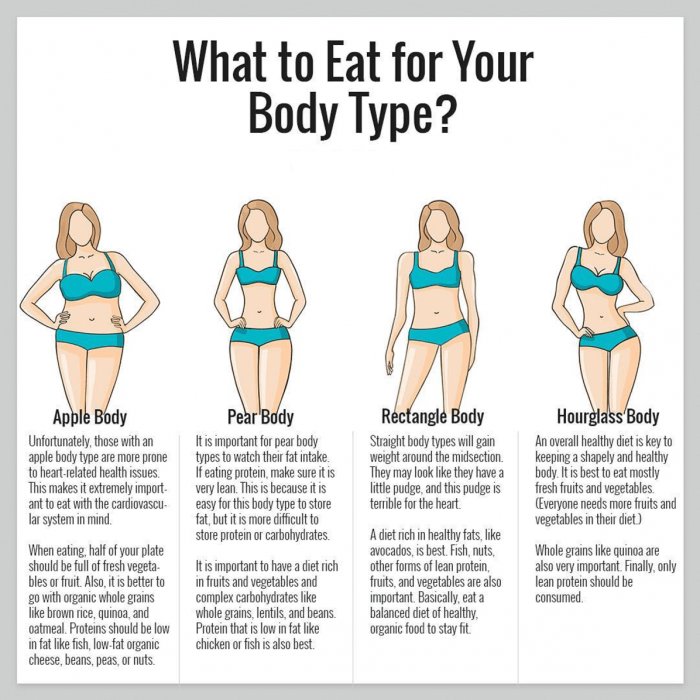
And to get more useful information every day, subscribe to our instagram.
#weight loss
Body types: ectomorphs, mesomorphs and endomorphs
Health
© shutterstock
Author
Alexander Artamonov
June 27, 2022
The structure of the figure will tell you how to play sports as efficiently as possible. But it is not necessary to build a diet on this basis. Explaining the differences between body types and their meaning with the experts
Body type is not only the width of the shoulders and hips and the distribution of fat. This parameter can also influence the rate of fat loss and gain and athletic performance. However, it makes no sense to give this parameter too much value.
- What is
- Ectomorph
- Mesomorph
- Endomorph
- Combined types
- How to identify
The material was commented on by:
- Liza Gilman, Head of the Department of Nutrition at the Atlas Biomedical Holding;
- Yaroslav Voloshkov, master trainer of the gym World Class Mitino
Advertising on RBC www. adv.rbc.ru
adv.rbc.ru
What are body types
Body types – ectomorph, endomorph and mesomorph – are ideal models of the structure of the human body and the model of its metabolism. These parameters are associated with the proportions of the figure, the distribution and amount of fat and muscle, the rate of weight gain and loss, as well as the effectiveness of training. Evidence-based science generally accepts this classification.
© shutterstock
The concept of somatotypes was developed in the 1940s. It was created by the American psychologist and physician William Sheldon. Since then, it has been used by fitness trainers, nutritionists and nutritionists to create personalized training and nutrition programs. Sheldon’s system formed the basis of the theory of the German psychologist Ernst Kretschmer, in which physiques are also divided into three types: asthenic, athletic, picnic.
Over the years, Sheldon’s theory has been heavily reworked, smoothed and nuanced. For example, it was originally assumed that the type of figure could not be changed. But today experts believe that it is real. For example, if an ectomorph constantly overeats and leads a sedentary lifestyle, over time it will acquire the features of an endomorph. “Furthermore, Sheldon originally believed that body size and shape helped define personality traits such as assertiveness, aggressiveness, shyness, and sensitivity , – says Lisa Gilman, head of the nutrition department of the Atlas biomedical holding. – He was wrong.”
For example, it was originally assumed that the type of figure could not be changed. But today experts believe that it is real. For example, if an ectomorph constantly overeats and leads a sedentary lifestyle, over time it will acquire the features of an endomorph. “Furthermore, Sheldon originally believed that body size and shape helped define personality traits such as assertiveness, aggressiveness, shyness, and sensitivity , – says Lisa Gilman, head of the nutrition department of the Atlas biomedical holding. – He was wrong.”
It is important to understand that ectomorph, endomorph and mesomorph are ideal types that almost never occur in their pure form. “In reality, almost every person is a mixture of body types, and most people can find common characteristics in one of three groups,” – adds Gilman.
The nutritionist also notes that body types should not be used as the basis for dieting: “For the vast majority of people, body typing creates more questions than answers. It makes nutrition unnecessarily difficult, and it rather distracts from the principles in nutrition that are important to focus on.
It makes nutrition unnecessarily difficult, and it rather distracts from the principles in nutrition that are important to focus on.
In addition, it is worth remembering that the parameters of a person’s body, the amount of fat and muscle in him are determined by many factors, and body type is not the most important of them. Lifestyle is much more important: the amount of physical activity, nutrition, bad habits and health status.
© shutterstock
Ectomorph
Ectomorph is the most thin type. Its representatives have narrow shoulders, chest and hips, long limbs with few muscles. Due to the accelerated metabolism, it is usually difficult for such people to gain mass, both muscle and fat – training and excess calories give little result. In the Kretschmer model, ectomorphism corresponds to an asthenic body type.
Among ectomorphs, hardgainers are often found – this sports term refers to people who find it very difficult to build muscle due to metabolic characteristics. There are especially many ectomorphs among catwalk models and basketball players. Stars of this type include Kate Moss, Zendaya and Timothée Chalamet.
There are especially many ectomorphs among catwalk models and basketball players. Stars of this type include Kate Moss, Zendaya and Timothée Chalamet.
“People from this category gain any weight very poorly, but it is most difficult for them to gain muscle mass, – explains coach Yaroslav Voloshkov. – This is in principle more difficult than losing weight, but it is still more difficult for them. In training, ectomorphs should prefer low-rep strength training, with a little extra activity, as these guys lose weight from literally everything. In nutrition, attention should be paid to observing calories.
Mesomorph
Mesomorph is an intermediate body type that is usually considered ideal. Such people have average dimensions, but the shoulders are wider than the hips, and the waist is narrow. Muscle mass and fat are evenly distributed throughout the body. Mesomorphs easily manage to both gain and lose weight. It is also relatively easy for them to gain muscle mass, and when playing sports, they quickly acquire developed and beautiful muscles.
In Kretschmer, a similar type is called athletic. Famous representatives of this type are Dwayne Scala Johnson and Madonna.
“We can say about mesomorphs that they are born to swing, – says Yaroslav Voloshkov. – There are no strict rules in training for them, they grow from everything, do not gain excess weight – they are genetically lucky. Of course, within reasonable limits. If a person in this group quits training and gorges on junk food, then the extra weight will not bypass him. But we can say that keeping themselves in shape is the easiest for them. ”
Endomorph
Endomorph – “stocky” type, prone to fullness. In his representatives, the hips and middle part of the body are wider than the shoulders, and growth is usually small. They easily gain weight and hardly get rid of it. The body of an endomorph, as the creator of the theory of somatotypes William Sheldon wrote, is “soft and rounded.” In Kretschmer’s concept, this type corresponds to the picnic type. Endomorphs, as a rule, have the most muscles, but it is very difficult to make them beautiful and embossed.
Endomorphs, as a rule, have the most muscles, but it is very difficult to make them beautiful and embossed.
This body type is often found in wrestling or American football. Celebrity endomorphs – Marilyn Monroe, Tom Hardy and J. Lo.
“Endomorphs very easily gain any weight, both muscle mass and fat, – says Yaroslav Voloshkov. – If a person with this type of figure sets himself the goal of losing weight, training must be very active – both during the warm-up and cool-down, and between sets. Endomorphs need to move more to increase their daily calorie expenditure. And, of course, strictly monitor nutrition.
© shutterstock
Combined body types
Some people have pronounced characteristics of both types at once. Common combined types include:
- ectomesomorphs — slender, but quite athletic people;
- ectoendomorphs with a pear figure – the general physique is thin, but a lot of fat is deposited in the thigh area;
- mesoendomorphs – athletic, but stocky;
- Apple-shaped endomorphs – a lot of fat accumulates on the abdomen, but the legs are slender, there may be an excess of visceral fat.

How to determine body type
You can try to determine your type by eye, simply by correlating the dimensions of the body and the experience of gaining and losing weight with their signs. But this will only work for pronounced representatives of their type, which is quite rare.
Another simple method is to measure your wrist. Grasp it with your thumb and forefinger just above the protruding bone. If your wrist is thin and your fingers overlap, then you are probably an ectomorph. If they connect, you are a mesomorph. And if the fingers do not reach each other – an endomorph.
There is a much more accurate method – the Heath-Carter method. It allows you to assess the degree to which your body belongs to each of the three types on a scale from 1 to 7.


 Reviews on Environmental Health. January–March 2002.
Reviews on Environmental Health. January–March 2002. It’s not necessary to go through long bouts of cardio if you find it especially grueling. Instead, consider interval sprints or high intensity interval training (HIIT), which will get your heart rate up but can be done in much shorter periods of time, says Feit.
It’s not necessary to go through long bouts of cardio if you find it especially grueling. Instead, consider interval sprints or high intensity interval training (HIIT), which will get your heart rate up but can be done in much shorter periods of time, says Feit.

